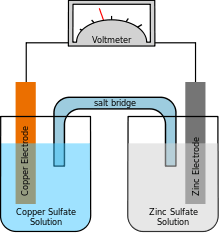Dry cell
.png)
1. brass cap, 2. plastic seal, 3. expansion space, 4. porous cardboard, 5. zinc can, 6. carbon rod, 7. chemical mixture.
A Dry cell is a type of electricity-producing chemical cell, commonly used today for many home and portable devices, often in the form of batteries. It was developed in 1886 by the German scientist Carl Gassner.
A dry cell uses a paste electrolyte, with only enough moisture to allow current to flow. Unlike a wet cell, a dry cell can operate in any orientation without spilling, as it contains no free liquid, making it suitable for portable equipment. By comparison, the first wet cells were typically fragile glass containers with lead rods hanging from the open top and needed careful handling to avoid spillage. Lead-acid battery did not achieve the safety and portability of the dry cell until the development of the gel battery. Wet cells have continued to be used for high drain applications such as starting internal combustion engines, because inhibiting electrolyte flow tends to reduce the current capability.
A common dry cell is the zinc-carbon cell, sometimes called the dry Leclanché cell, with a nominal voltage of 1.5 volts, the same as the alkaline cell (since both use the same zinc–manganese dioxide combination).
A standard dry cell comprises a zinc anode, usually in the form of a cylindrical pot, with a carbon cathode in the form of a central rod. The electrolyte is ammonium chloride in the form of a paste next to the zinc anode. The remaining space between the electrolyte and carbon cathode is taken up by a second paste consisting of ammonium chloride and manganese dioxide, the latter acting as a depolariser. In some designs, the ammonium chloride is replaced by zinc chloride.
History
Many experimenters tried to immobilize the electrolyte of an electrochemical cell to make it more convenient to use. The Zamboni pile of 1812 was a high-voltage dry battery but capable of delivering only minute currents. Various experiments were made with cellulose, sawdust, spun glass, asbestos fibers, and gelatine.[1]
In 1886, Carl Gassner obtained a German patent (No. 37,758) on a variant of the Leclanché cell, which came to be known as the dry cell because it did not have a free liquid electrolyte. Instead, the ammonium chloride was mixed with Plaster of Paris to create a paste, with a small amount of zinc chloride added in to extend the shelf life. The manganese dioxide cathode was dipped in this paste, and both were sealed in a zinc shell, which also acted as the anode. In November 1887, he obtained U.S. Patent 373,064 for the same device.[2]
Unlike previous wet cells, Gassner's dry cell was more solid, did not require maintenance, did not spill, and could be used in any orientation. It provided a potential of 1.5 volts. The first mass-produced model was the Columbia dry cell, first marketed by the National Carbon Company in 1896.[3] The NCC improved Gassner's model by replacing the plaster of Paris with coiled cardboard, an innovation that left more space for the cathode and made the battery easier to assemble. It was the first convenient battery for the masses and made portable electrical devices practical.
The zinc-carbon cell (as it came to be known) are still manufactured today.
Dry cell types
- Primary cell
- Zinc-carbon cells, also known as Leclanché cells
- Alkaline cell
- Lithium cell
- Mercury cell
- silver oxide cell
- Secondary cell
Primary cells are not rechargeable and are generally disposed of after their chemicals have been used up through the cell's internal reaction.
Secondary cells are rechargeable, and may be reused multiple times.
See also
References
- ↑ W. E. Ayrton Practical Electricity; A Laboratory and Lecture Course for First Year ... 1897, reprint Read Books, 2008 ISBN 1-4086-9150-7, page 458
- ↑ http://todayinsci.com/G/Gassner_Carl/GassnerPatent373064.htm
- ↑ "The Columbia Dry Cell Battery". National Historic Chemical Landmarks. American Chemical Society. Retrieved 2014-02-21.
